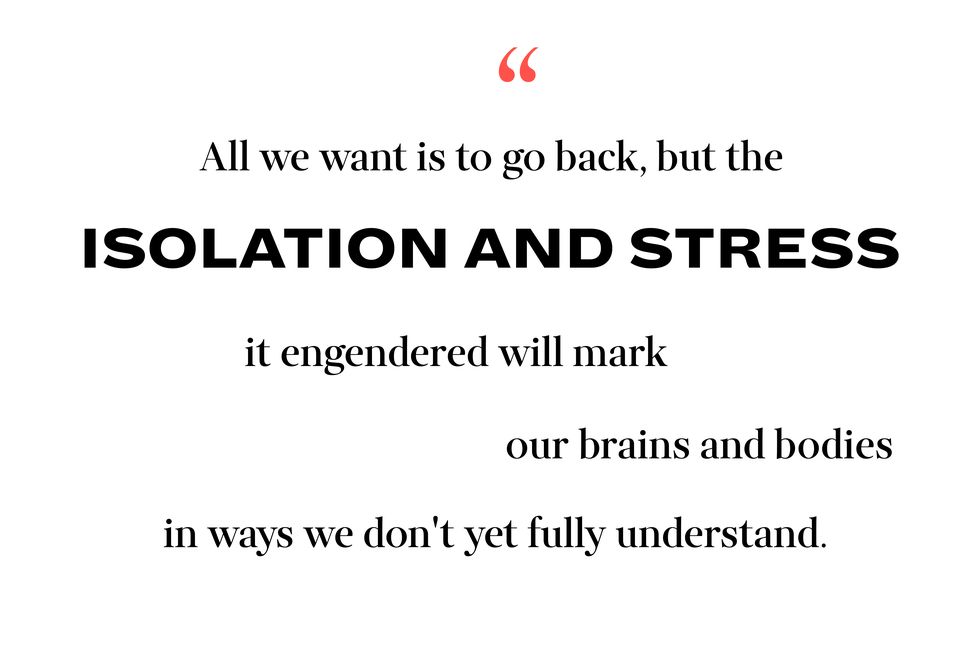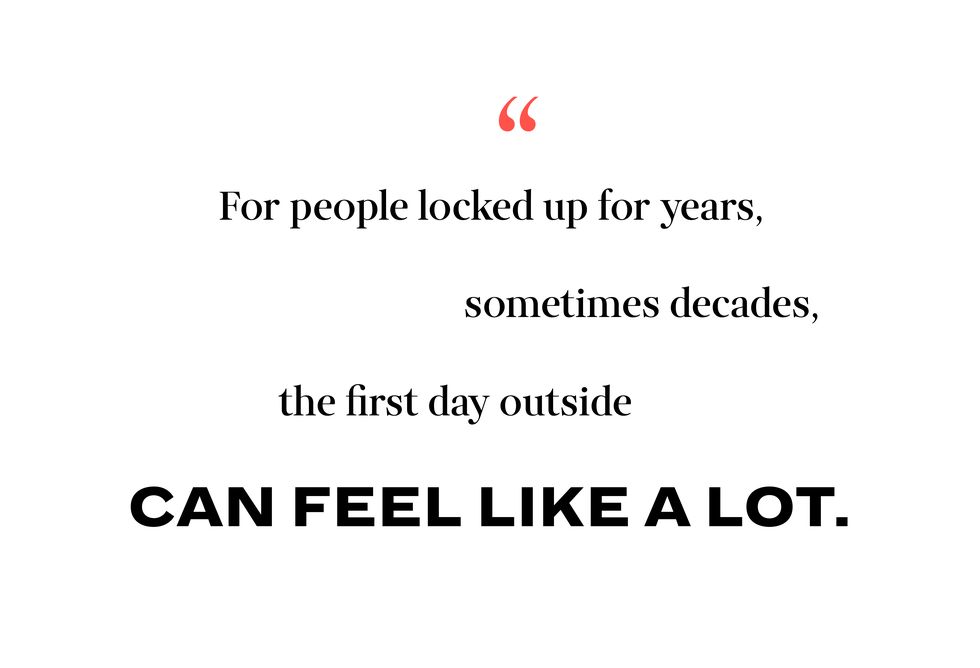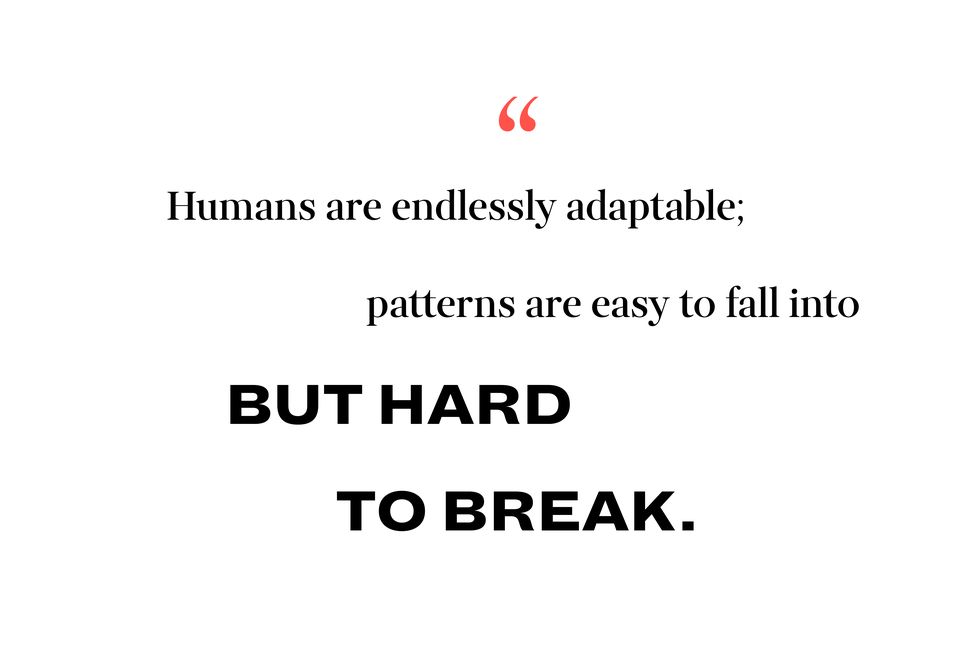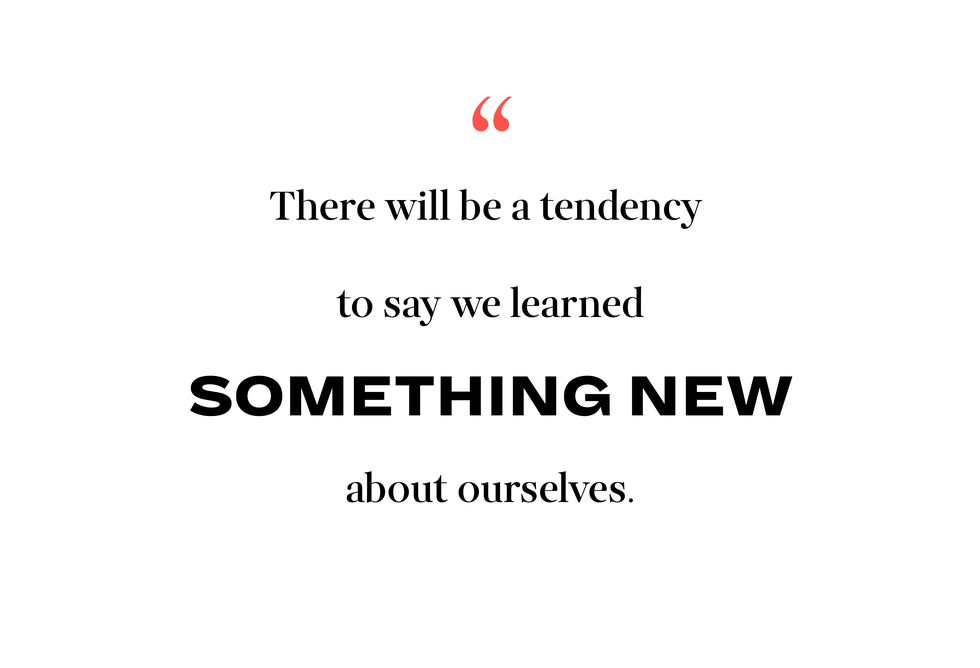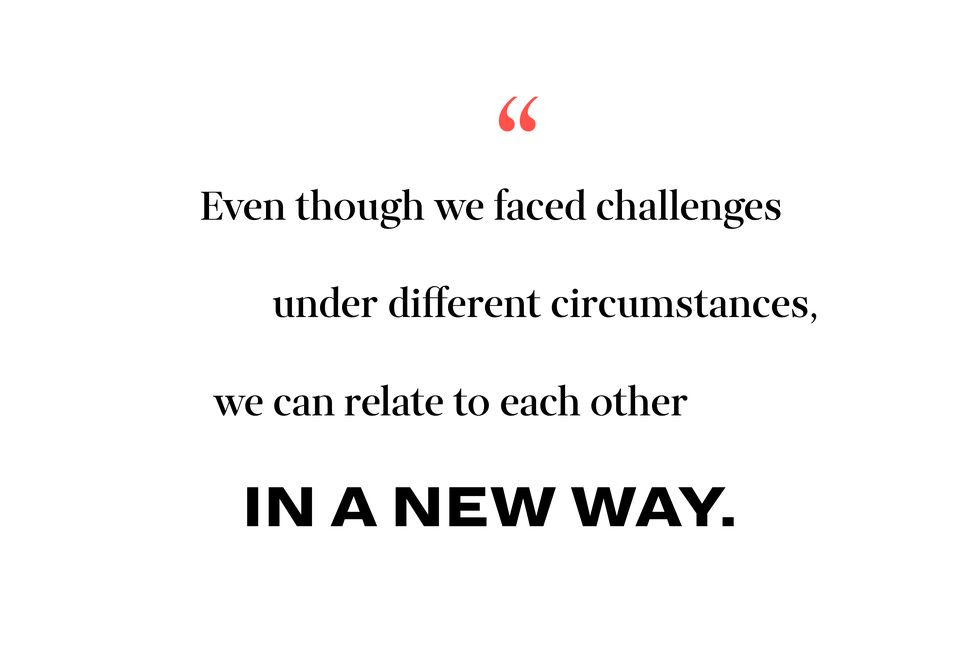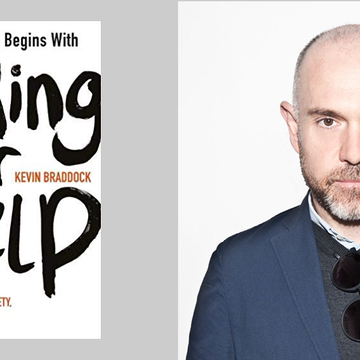Last year, after the novelty of being confined to our homes wore off and the panic over the world ending abated a little, many people started playing a game, which has endured as the months rolled on and the sun withdrew and then crept out again. What's the first thing you'll do when all this is over?
Some dream of sitting in a cold cinema and hearing the audience hush as the film starts. Others want to brush up against strangers in the flushed throng of a gig. Some people want to go to the airport without a ticket, others to sit with a pint outside their local pub. If that means side-eyeing the people occupying their favourite seat until they leave, then things really are back to normal.
The game is a fantasy which hinges on another fantasy: that when Covid-19 recedes, we'll each return to being the person we were the day before it crashed over us. But even as it's become clear that the pandemic won't simply disappear one morning, the hope that we'll exit its cocoon untransformed is a more persistent myth. The isolation and stress it engendered have marked our brains and bodies in ways we don't yet fully understand. We're about to discover how deep those marks go.
This month, as the United Kingdom takes its first, faltering steps toward normality, we are beginning the journey home after a long mission. What will reality be like compared to our expectations? How long will it take to feel normal again? And how quickly will we forget where we have been?
Psychologists have a term for the collapse in morale that occurs just after the halfway point of a prolonged period of isolation: the ‘third quarter phenomenon’. First coined in a 1991 study, the theory goes that the cumulative effects of boredom, tension with the people you're locked up with, and distance from the finish line, can become overwhelming. The world you're stuck in has lost its novelty, and escape feels far away.
What we're about to experience is referred to by some as 'fifth quarter syndrome': a return to normality that, for some, can be an even tougher transition than the time spent in isolation. In a study of Japanese scientists wintering over in Antarctica, the fifth quarter syndrome is seen as a kind of thawing after returning from the cold, one where "dramatic changes in this wholly novel environment appear one after another" and "adaptation is a continuous process". Subjects reported difficulties re-engaging at work and dips in motivation that lasted as long as a year after re-entering society. Those who'd acclimatised to Arctic conditions most readily found the return home the hardest. As the study's authors put it: "Human society may be harder to adapt to than the Antarctic."
In the UK, the most recent lockdown, which has dragged on for the first four months of the year, has felt like our third quarter of the pandemic, a period of treading water and dreaming of the end of restrictions. What we are less able to imagine is what comes after that ending, and if that will bring a new kind of challenge instead of a simple return to life before.
“You kind of lose your freedom in a different way,” says psychologist Anders Kjærgaard. “Whether you’re on a space station or in a group of soldiers, life becomes a bubble and then that bubble bursts when you get home and you have to readjust to normal life.”
Kjærgaard is a psychologist and former officer with the Danish military. He served with an elite Danish naval unit called Sledge Patrol Sirius, based in a frozen expanse of north-east Greenland. Fewer than 30 people live in an area more than four times the size of the UK, and eleven of them were on his team. When the sun sinks below the horizon in late November, not to be seen again until the end of January, it's one of the loneliest places on the planet.
Kjærgaard's experiences there, and background in psychology, inspired him to study the effects of isolation. In his work now he sees patterns emerge in soldiers who have been isolated with a small group of the same people for too long: they are weary, they want to go home. “In the long run, small things tend to feel bigger,” he tells me, drawing parallels with how we non-soldiers have experienced the last 12 months. “I think people are tired of the restrictions and of trying to conform. We just want normal life, whatever that is, back.”
The first days
Carlos Cervantes knows what the first moments of freedom look like better than anyone. Together with a fellow ex-convict, Roby So, he helped set up the Ride Home Program, a partnership between the Three Strikes Project at Stanford Law School and the Anti-Recidivism Coalition, which since 2013 has picked up inmates on the day they are released and driven them to their transitional housing.
Cervantes spent almost eleven years in prison, and it wasn't until he found himself standing on the other side of the gates that believed he would ever really be free. Now, each time he waits by the car for another prisoner to take his first free steps, among their swirling emotions he can always spot a sense of awe at the world unfolding in front of them, like a dream they can’t fully remember.
For people locked up for years, sometimes decades, the first day outside can feel like a lot. In some former prisoners, big crowds can spark panic attacks, so Cervantes builds up to the potentially intimidating stuff gradually.“It’s a slow pace,” he says. “Typically prisons are a three or four hour drive away [from their housing] which is great, because you’re in the middle of nowhere. First we go to a convenience store to get snacks, then we get on the road.”
The next step is a meal, where former convicts have to contend with the glut of options on menus, as well as breaking bread sat with people of different races, often uncommon in prisons. Sometimes people want to keep ordering from the menu because they can, or stop off at a record shop and listen to music, or simply look around and explore without restrictions. When Cervantes's passenger is ready he takes them to a big clothing shop, to prepare them for the overwhelming number of options now available to them. “People are used to having two choices of deodorant and now they have 45,” he says. “We make them pick what kind of toothpaste and shirts they want, it’s a sense of independence, They’re happy to be out but they’re also thinking, ‘Man what lies ahead?’”
When Cervantes got out, his path back into society wasn’t clear. At 16 he took a plea bargain for an attempted murder and was given 12 years inside, eventually getting out after ten years and eight months. Then, at 27, he was a free man, with $200 in his hand to go and make a new life. Like many former convicts, Cervantes was put on a Greyhound bus with an address, but no idea how to navigate the strange new world he'd landed in. The Ride Home Program smooths that transition by gently delivering someone back into society.
There's much we can take from the experiences of Cervantes's clients, even if our own won’t be as severe as discovering phones can now talk and cars don't have keys. The slow act of getting used to the loud, busy world out there is something we will all have to relearn. It might help that the roadmap out of lockdown is a series of 'firsts' – rule of six; pub beer gardens; overnight stays; nightclubs – that provide a set of stepping stones back to normality.
Former Nasa astronaut Scott Kelly's return to Earth, after a year on the International Space Station, was more abrupt. He plunged back into another atmosphere at 17,000 mph; the wind, sun and rain he had been missing tore at the window of his Soyuz capsule. He remembers the strangeness of the first few encounters with normal life. Seeing a dog for the first time was like encountering an alien being.
Kelly is as unflappable and measured as you would expect from someone who spent 340 days in space, an American record. He speaks about orbiting the Earth in a way that takes in both the practical and spiritual elements of the journey. When he eventually returned to Earth, he was struck by the small things he had not been able to do for so long, like eat a meal without his fork floating away, or jump into water. “When you’re isolated for that long of a period of time, things like crowds, or the availability of things that planet Earth has to offer, is a little bit overwhelming,” he says.
You don't need to spend a year orbiting the Earth to experience that sense of disjunction. Kjærgaard predicts that what was once a workaday will be disorientating after so long living under restrictions. “The first couple of days and weeks will be a little stressful, in a way,” he says. “Because you have to get used to everything: there’s a lot of noise, pollution, waiting lines, traffic jams.”
In 2014, Kjærgaard co-authored a study into the social reintegration of a 29-year-old friend, referred to as 'C', who'd spent nine months sailing solo around the world, unsponsored and without support, on his family's 40-year-old cruising yacht. It was a lonely journey – for three-month periods, C wouldn't see as much as a ship or an aircraft. After 260 days, his journey ended bitterly when, navigating up the Channel, a 20-knot wind whipped up as he was preparing food in the yacht's kitchen. He heard a loud smack above him and shot above deck to find his mast had snapped in two. Heartbreakingly, he was just 600 miles from his home port of Skagen.
During the journey, C had faced most challenges with an overwhelming sense of optimism. The study's authors noted his sense of agency, fuelled by a belief that the things that happened to him were his to control, not the whim of some intangible higher force. C even found the positives in his evacuation in the Channel. "Imagine if it had happened in the middle of the Southern Ocean or in the Pacific," he told the researchers in an interview. "I hardly dare to think about it. Also it could have happened under much worse weather conditions [...] So really it was extremely fortunate. It was a starry night and I could see the countryside and the evacuation all went smoothly. So it was almost touching how fortunate a place it happened in."
When C got home, though, things got tougher. Rather than luxuriating in the comforts and social interactions he'd missed at sea, he found it hard to be around other people and had difficulty concentrating on a book he wanted to write. He obsessed over what he saw as a failure at the end of his journey, even though by crossing his departure line in the Channel he'd technically completed the circumnavigation unaided.
He had achieved so much and survived extreme conditions, and yet in the immediate aftermath he didn't feel like what he had done was a success. Though he had returned to normality, it took a long time before he could fully return to himself.
The first month
In prison, Cervantes learnt to stash the peanut butter sachets from Thursday's meal until Mondays – pancake day – so he could smear them on his stack. He still eats his pancakes with peanut butter, unable to shake the habit even in the decade he's been out. Life inside is tightly structured – certain foods on set days; exercise at set times – and over years, those rhythms become deeply embedded. Cervantes sees lots of people who struggle to not turn up somewhere an hour early for fear of being late, or who still wake up at 4.30 every morning. Hugs from family members can feel like being smothered after not being touched for so long. “It’s hard to get out of that mindset,” he says. “I tell people they have to rewire their whole brain because they’re so accustomed to the single colour for their clothes, or being by themselves, or the prison coffee.”
Lockdown is not prison (even when we were only allowed an hour of exercise per day), but prison re-entry can still offer a parallel for our return to society. Humans are endlessly adaptable; patterns are easy to fall into but hard to break. Forced to find our balance as the world tilted, the pandemic imposed new routines on us that will still be coded in our minds during the first weeks of normal life returning.
When Kelly was in space his routine was out of his hands. He got used to a schedule in which decisions about his day were controlled from afar. “At first it’s very hard to get used to living like that but then, as you grow accustomed to it, it’s kind of hard to get used to not living like that,” he says. “I found that once I had a lot of choices available to me and I was controlling my own schedule, I didn’t really know what to do.”
Even without your own mission control, or prison guards, dictating when you eat and sleep, the massive reduction in what we can choose to do has had a similar effect. Over the last year we have grown used to not cramming our weekends with plans, getting home late to find nothing in the fridge, or even deciding what time to leave the house for work. Now, with life opening up again, the endless choices can easily become overwhelming. “I think there is an element of PTSD to reintegrating yourself to normal life,” Kelly says. “People are going to have to slowly dip their toes in because there’s definitely a potential to overdo it. You feel like you’re making up for lost time.”
Moriel Zelikowsky is an expert in that particular transition. A neuroscientist at the University of Utah School of Medicine, for years Zelikowsky found that her research into social isolation was of little interest to most people. ‘Who cares about something which largely affects prisoners?’ people would infer when speaking to her. Of course, that has changed dramatically in the last year, with her research drawing a map of how social isolation alters our brain chemistry.
“One of the best and most dependable ways that you see violence across animal species is to socially isolate them,” Zelikowsky tells me. She became interested in the subject after seeing that school shooters in America were often isolated, or reported feeling so even if they weren’t physically alone. Her research has isolated a neuropeptide, called Tac2, which builds up in the brain after prolonged isolation. Neuropeptides are chemicals that control the transmission of messages in the brain, and research has shown that when Tac2 rises in the hypothalamus and the amygdala – regions connected to emotional regulation – levels of aggression and fear spike.
“What an increase in the neuropeptide does really is tip the system over to being closer to that red line that would flip you over into an aggressive act, or an overly afraid feeling,” she says. “You no longer need a big push to feel that you want to punch someone.” Zelikowsky has observed that when Tac2 builds up over a long period of time in mice, they reach a point of no return. “You actually can’t really put them back because they just end up killing each other in the cages."
This type of isolation, it should be said, is far more extreme than most people will have endured in the last year, and although our social lives have shrunk measurably, we've potentially protected ourselves from returning from isolation with the same sense of shock as a prisoner or astronaut (or lab mouse) via the new ways through which we've maintained social connections. Whether it's a Zoom birthday party or the simple act of smiling behind our mask at the person ringing up our shopping in the supermarket, social interactions counteract the Tac2 building up in our brains, like a life raft making the journey back to shore less treacherous. Still, it is hard to quantify exactly how much of a difference these mediated connections will have made. In Zelikowsky's experiments, mice that can see other animals but can't play or interact with them experience similar levels of aggression and fear as those left completely alone.
The key may be to counteract the damage before it is done. One of Kjærgaard's focuses is combating the effects of PTSD, and he's found that prevention is at least as important as cure. The greatest protection comes not from post-mission therapies, but when soldiers have social support while they are on duty that continues when they get home. It could be that, by forcing us to maintain connections in novel ways, or even contact friends and family members we might not otherwise have spoken to for months, the mission we’ve been on has been quietly preparing us for re-entry the whole time.
The first six months
Scott Kelly's body began to acclimate as soon as he returned home, but his wife thinks it took eight months for him to come fully back to Earth mentally and emotionally. Kelly sums his feelings up by paraphrasing Gennadi Manakov, a Russian cosmonaut who spent 309 days in space across two missions: “He would say that to astronauts and cosmonauts, when we’re on Earth we miss space and when we’re in space we miss Earth.” A few months into regular life, with its delayed trains and FOMO, the quiet of the pandemic might look quite appealing again.
Cervantes sees this in prisoners who struggle to let go of parts of being inside, with some even creating replicas of their cells inside their houses because living with so much space is overwhelming. “I think that’s part of being institutionalised and how these things are ingrained in you,” he says.
Kjærgaard predicts that, as we move further from the pandemic, we'll reframe how we experienced it. “I think there will be a tendency to say we learned something new about ourselves,” he says. He points to a concept called 'post-traumatic growth' – "Which is a debated term, because how do you measure growth?" – in which trauma forges positive change in the person who survives its heat. This growth comes in one of five categories. In the first, relationships grow in intensity as you cast off people you see as a waste of time, and focus instead on those you genuinely want to be with. The second opens up new possibilities. "They think: 'Now I've done this, I can do anything'." Third is a renewed optimism about challenges that arise in future. Fourth, a growing appreciation for the smaller things in life, "at least for a period of time." The final category, spiritual change, thanks some higher power for their survival.
Kjærgaard says that people often grow within one or two of these areas after facing a challenge, and that the growth might peak before normal life brings us back down again. In the study of the around-the-world sailor, his research concluded that the psychosocial aftermath of the subject’s expedition was eventually positive, with “perceptions of personal growth as a result of his experience” and “a consistent belief system that he was in control of his own destiny”.
How we frame our own stories depends partly on who we are, but also the circumstances that the pandemic locked us in. For those isolating without money troubles, living in large houses, in stable employment, and who have not known anyone become seriously ill or die, the year could be totted up as an inconvenient break on travel plans. For many others there will be real and enduring trauma.
Zelikowsky believes that those most likely to suffer the long-term effects of isolation are on an inverted bell curve, with adolescents and the elderly hit hardest. The latter group has received by far the most research; we already know that social isolation causes an increased mortality rate of 35 per cent in people over 65. For the young, who are forming key social relationships, the long-term effects of shutting off their social lives are a worrying unknown. “A lot of those social circuits are still kind of plastic at a young age, so are still developing in a critical period,” she says. “Even before Covid young people have been using social media as a replacement for social interaction and due to that, it’s reported they feel more lonely than ever before. I think we do need this physical interaction and you just can’t get it back over the phone.”
Is it possible that the same violence seen in isolated rats could push us over the edge? Will we see people unable to return to a more connected society? Ahead of their hoped-for 21 June reopening, nightclubs and gig venues have started training staff for panic attacks and fights, as people negotiate new ideas around appropriate personal space and levels of physical contact. It might be that the longed-for end of lockdown doesn't quite cue up the summer of love we're all picturing.
Zelikowsky already believes we have already seen signs of these new tensions in the rise in domestic violence during the pandemic, and videos of people scrapping over toilet paper in the supermarket. “There are all kinds of other things that happen when you’re isolated: people are more anxious, there are higher incidences of depression and drug addiction, and overdoses are on the up,” she says. “One could potentially consider that a lot of the recent riots and unrest in America is probably a combination of the political atmosphere but also people feeling alone and pent-up. People’s brains are literally changing due to that period of isolation.”
The first year
Kjærgaard wonders, when this is over, how long we'll remember everything which felt so all-encompassing: the months that lasted for years and the year that felt like it would never end. “History shows that we tend to forget,” he says. “We might look back and think, ‘that time during the pandemic, that was hard’, but the stories become better over the years.” Just as the Blitz is often twisted into a national mythology of community and civic spirit, in time we might remember clapping for carers more readily than the gurneys piled up in A&E departments.
On the anniversary of the first UK lockdown, people looked back to their last normal week, imagining the disbelief they would have felt if they knew what was coming. Websites ran side-by-side comparison photos of tourist spots and theme parks a year on: once crowded and now empty. It is not impossible that in another 12 months, the photos might invert again. We might look at images of the pandemic as strangely as we now see pictures of unmasked crowds.
“Memory is susceptible to alterations,” says Zelikowsky, “so I think with time you may retrieve [memories] and update them and not remember it as we’re living it now. With time, the trauma of what happened will start to slowly extinguish.”
If forgetting is inevitable, then what we have been through presents us with an opportunity to grow. If we are to learn anything from the experience, Kjærgaard hopes that it might bring us closer together globally. “On behalf of humanity I might become optimistic that there’s an open window for us to get a better understanding of each other,” he says. “Even though we faced challenges under different circumstances, we can relate to each other in a new way I think.” Kelly, too, wonders if shared trauma might steer us towards an astronaut's-eye view of humanity. “You don’t see countries and political borders,” he says. “I hope when this is all over we realise we’re all part of the same team.”
And there's more at stake than just a kumbaya moment. As competition for vaccine supplies intensifies, the sense of all being in this together is already evaporating under the heat of capitalist competition. As Jeremy Farrar, the head of the Wellcome Trust, put it: "Until we are all safe, no one is safe." When we celebrate the all-clear in Britain – whether that comes on 21 June, or sometime in 2022 – we would do well to remember the developing countries where vaccine delivery has stalled, where the pandemic still rages. To forget them would be not just a failure of basic human empathy, but also invite Covid-19 back to Britain in some mutated, vaccine-resistant new form.
In Kjærgaard’s sailing study, C found that 15 months after returning home, he had settled within himself. He focused his attention on his partner and starting a family. “I had to sail around the world for nine months to find out I am a social person,” he told researchers. In reintegrating to society, it was social connection which brought him back to shore when he felt adrift. The power of other people to protect us from the psychological effects of what we have been through are important both while we feel isolated, and as we return to normality. This connection isn’t merely about being surrounded by a crowd of people physically, but maintaining close personal connections.
Cervantes emphasises the importance of social support once people are freed, knowing that their journey with prisoners continues for years. He still gets 25 calls a day from people who are out and have a connection to the first face they saw waiting for them in the parking lot when they walked into their new life. “Creating plans, always showing support and being there for them is important,” he says. In the Ride Home Program there is a model of how to look out for people as they come back to society from something far lonelier, longer and more frightening than any of us have experienced in the last year.
He knows taking things slowly and not becoming overwhelmed by what might come next is the best way to dip your toe into the waters of the world waiting out there. He points out that re-entering society doesn’t just take away your problems, it gives you new ones to worry about too. “Do you know what we call those?” he says. “Free-man problems”.
Like this article? Sign up to our newsletter to get more articles like this delivered straight to your inbox

